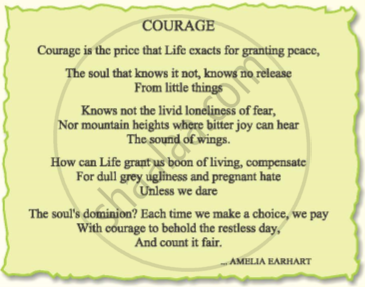Advertisements
Advertisements
Question
Fill in the blank to name a different kind of intelligence. One has been done for you.
When I enjoy listening to people and solving their problems I use my interpersonal intelligence
When I enjoy dancing or physical activity, I use my ____________ intelligence.
Solution
When I enjoy dancing or physical activity, I use my bodily intelligence.
APPEARS IN
RELATED QUESTIONS
Irony is when we say one thing but mean another, usually the opposite of what we say. When someone makes a mistake and you say, Oh! That was clever!” that is irony. You’re saying ‘clever’ to mean ‘not clever’.
Expressions we often use in an ironic fashion are:
• Oh, wasn’t that clever!/Oh that was clever!
• You have been a great help, I must say!
• You’ve got yourself into a lovely mess, haven’t you?
• Oh, very funny!/How funny!
We use a slightly different tone of voice when we use these words ironically.
Read the play carefully and find the words and expressions Gerrard uses in an ironic way.
Then say what these expressions really mean. Two examples have been given below.
Write down three such expressions along with what they really mean.
| What the author says | What he means |
| Why, this is a surprise, Mr – er – |
He pretends that the intruder is a social visitor whom he is welcoming. In this way he hides his fear. |
| At last a sympathetic audience! | He pretends that the intruder wants to listen to him, whereas actually the intruder wants to find out information for his own use. |
Why does the author say that Iswaran seemed to more than make up for the absence of a TV in Mahendra’s living quarters?
Can you think of some other ending for the story?
Why do the courtiers call the prince ‘the Happy Prince’? Is he really happy? What does he see all around him?
Complete the following statement.
From her room in Kasturba Hostel, Santosh used to _________
Read the newspaper clipping.

Listen to an interview between the police inspector in charge of the case, the housekeeper, Ms. Lakshmi and the watchman, Ram Singh. As you listen, note down the details of the burglar.
Inspector: Hello, madam. I am Inspector Maan Singh. I am in charge of the burglary
case which occurred in the flat of your employer, Mr. Ravikant. It must have
been a harrowing experience for you.
Lakshmi: Yes, it was a terrible experience. People like that should be locked up in a
prison.
Inspector: If you will cooperate with us, we will catch them in no time. Were you alone
in the apartment at that time?
Lakshmi: Yes, it was 11 :30 in the night and I was alone as my master and his wife had
left for Shimla.
Inspector: How do you think the burglar gained entry into the house?
Lakshmi: He might have come through the balcony and entered my room.
Inspector: Now tell me something about his physique. What about his build? How tall
was he?
Lakshmi: He was about 6 ft tall.
Inspector: What about his physique?
Lakshmi: He was not thin. He was well-built and rather plump.
Inspector: What about his dress? What was he wearing?
Lakshmi: I think his clothes were rather old and faded. He was wearing a black shirt
which was faded.
Inspector: Do you remember the colour of his trousers?
Lakshmi: They were of a dark shade -either black or blue.
Inspector: Can you tell me something about his face?
Lakshmi: Unfortunately no. When he entered my room I panicked. But then I
gathered courage and screamed and tried to run away. But I was a bit late.
He struck me with a staff and I really don't remember anything after that.
May be I was knocked out.
Later on, I came to know that he broke into the bedroom and ran off with the
jewellery. But Ram Singh, the watchman, who tried to catch him may be
able to describe him better.
Inspector: OK Lakshmi, thank you! If I need your help I will come again. You may have
to identify the burglar. Now, I will speak to Ram Singh.
Inspector to Ram Singh:
Ram Singh you were on duty and you tried to catch the burglar. You may be
able to give a good description of him. First, tell me about his hair.
Ram Singh: He had straight black hair.
Inspector: What about the shape of his face and his complexion?
Ram Singh: He had an oval face with grey eyes and I think he was dark complexioned.
Inspector: Did he wear spectacles?
Ram Singh: Yes, with a plastic frame and his nose was rather sharp.
Inspector: What else can you remember about him? What about his teeth and lips?
Ram Singh: His lips were quite thick.
Inspector: Is there anything else that you remember about him?
Ram Singh: When I heard some noise from inside, I ran in. I tried to stop the burglar and
we had a scuffie. During the struggle I noticed that he had six fingers on his
right hand. But he managed to run away and made good his escape on a
motorbike.
Inspector: Thank you Ram Singh. We will make sketches on the basis of your
description and nab him.
a) Read the second stanza again, in which Wordsworth compares the solitary
reaper's song with the song of the nightingale and the cuckoo. On the basis of
your reading (and your imagination), copy and complete the table below. (Work
in groups of four, then have a brief class discussion.
| Place | Heard by | Impact on listener | |
| Solitary Reaper | Scottish Highlands | the poet | holds him spellbound |
| Nightingale | |||
| Cuckoo |
b) Why do you think Wordsworth has chosen the song of the nightingale and the
cuckoo, for comparison with the solitary reaper's song?
c) As you read the second stanza, what images come to your mind? Be ready to
describe them in your own words, to the rest of the class. (Be imaginative
enough and go beyond what the poet has written.)
The world's most famous female aviator, Amelia Earhart, disappeared in 1937, as she attempted to become the first woman to fly around the world with her navigator, Fred Noonan. She was last heard when she was around 100 miles from the tiny Pacific Howland Island on July 2, 1937.
Read the story of her 'Final Flight'.
On June 1, 1937 Amelia and her navigator Fred Noonan departed from Miami, Florida; bound for California. Their first destination was San Juan, Puerto Rico; from there, skirting the northeast edge of South America; and then on to Africa and the Red Sea.
The flight to Karachi was another first. No one had previously flown non-stop from the Red Sea to India before. From Karachi, the Electra flew to Calcutta on June 17 from there on, to Rangoon, Bangkok, Singapore and Bandoeng.
The monsoon prevented departure from Bandoeng for several days. Repairs were made on some of the 'long distance' instruments which had given trouble previously. During this time, Amelia became ill, and suffered from dysentery that lasted several days.
It was June 27 before Amelia and Noonan were able to leave Bandoeng for Port Darwin, Australia. At Darwin, the direction finder was repaired, and the parachutes were packed and shipped home as they would be of no value over the Pacific .
Amelia reached Lae in New Guinea on June 29. At this point they had flown 22,000 miles and there were 7,000 more to go over the Pacific. Amelia cabled her last commissioned article to the Herald Tribune. Photos show her looking very tired and ill during her time at Lac.
The U.S. Coast Guard cutter, Itasca had been standing off Howland Island for some day to act as a radio contact for Amelia Radio communications in the area were very poor as Itasca was overwhelmed with commercial radio traffic that the flight had generated .

Amelie left Lae at preciaely 00:00 hours Greenwich Mean Time on July 2 . It is believed that the Electra was loaded with 1,000 gallons of fuel , allowing for 20-21 hours of flying .
At 07:20 hours GMT Amelia provided a position report placing the Electra on course as some 20 miles southwest of the Nukumanu Islands . The last weather report Amelia was known to have received was before take-off . The head wind speed had increased by 10-12 mph, but it is not known if she ever received the report.
At 08:00 GMT Amelia made her last radio contact with Lae . she reported being on course for Howland Island at 12,000 feet . There is no real evidence as to the precise track of the aircraft after Nukumanu . No one saw or heard the plane fly over .
Several short transmissions were received by the Itasca with varying signal strengths but they were unable to get a fix on her location because they were too brief. At 19:30 GMT the following transmission was received from the Electra at maximum strength.
"KHAQQ calling Itasca. We must be on you but cannot see you ... gas is running low ... "
At 20: 14 GMT, the Itasca received the last voice transmission from Amelia giving positioning data. The Itasca continued to transmit on all frequencies until 21:30 hours GMT. They determined that Amelia must have died at sea and began to implement search procedures.
It has been determined that the plane went down some 35-100 miles off the coast of Howland Island. A life raft was stowed on board but no trace was ever found of the raft. Some experts felt that the empty fuel tanks could keep the plane afloat for a period of time.
President Roosevelt authorized a search party of 9 naval ships and 66 aircrafts at an estimated cost of over $4 million. On July 18, the search was abandoned by ships in the Howland area. George continued to seek help in the search, but by October he too abandoned all hope of finding them alive.
Amelia had been sending letters to George at stopovers all along her route quite regularly. These were published in the book 'Last Flight'. The book has a note from her to George ....
"Please know I am quite aware of the hazards ... I want to do it because I want to do it. Women must try to do things as men have tried. If they fail, their failure must be, but a challenge to others. "

Amelia created a number of aviation records :
o The first woman to fly across the Atlantic in 1928
o The second person to fly solo across the Atlantic in 1932
o The first person to fly solo from Hawaii to California in 1935 Guided by her publicist and husband, George Putnam, she made headlines in an era when aviation had gripped the public's imagination.
This is a meeting of the school's Parent-Teacher Association. Some student representatives have also been invited to participate to discuss the role that Information Technology I Computers play in the growth and development of children.

Read the extract given below and answer the questions that follow :
Bassanio: A gentle scroll. - Fair lady, by your leave; (Kissing her)
I come by not, to give and to receive.
Like one of two contending in a prize,
That thinks he hath done well in people's eyes
Hearing applause and universal shout
Giddy in spirit, still gazing, in a doubt
Whether those peals of praise be his or no;
(i) Where did Bassanio find the 'gentle scroll'? What 'prize' had Bassanio just won?
(ii) Explain why Basscmio said he felt 'Giddy in spirit, still gazing, in a doubt'.
(iii) Shortly after this exchange, Port: it gave Bassanio a ring as a token of her affection. What did the gift symbolize?
(iv) What assurance did Bassanio give her when he accepted the ring?
(v) What did Portia urge Bassanio to do when she learned that his friend Antonio was in trouble? What aspect of her character is revealed through her words?
Read the extract given below and answer the questions that follow :
Giles: I beg your pardon. Did you say something?
Trotter: Yes, Mr. Ralston, I said ‘Is there an extension ?’ (He crosses to Centre.)
Giles: Yes, up in our bedroom.
Trotter: Go and try it up there for me, will you?
(Giles exits to the stairs, carrying the glove and bus ticket and looking dazed. Trotter continues to trace the wire to the window. He pulls back the curtain and opens the window, trying to follow the wire. He crosses to the arch up Right, goes out and returns with a torch. He moves to the window, jumps out and bends down, looking, then disappears out of sight. It is practically dark. Mrs. Boyle enters from the library up Left, shivers and notices the open window.)
Mrs Boyle: (Moving to the window) Who has left this window open?
(i) Why did Giles fail to hear what Trotter had said earlier·? Why did Giles look 'dazed'?
(ii) What was Trotter attempting to do? Why?
(iii) Why did Mrs. Boyle close the window? What did tl1e voice on the radio say about the 'mechanics of fear'?
(iv) How did the murderer mask the sounds of the killing? Who entered the room immediately after the murder? What did this person see?
(v) Who was the victim? Why was the victim murdered? What was the 'signature tune' that the murderer whistled? What is the significance of this tune in the context of the play?
What proves that Mr Gessler was not an Englishman?
Describe the boots made by Mr Gessler.
Was it right for the author’s friend to dismantle the bicycle?
Narrate the story of the reptiles as told by Zai Whitaker in not more than 80 words.
What do you think the talking fan was demanding?
Multiple Choice Question:
Inner beauty of a person is shown in______
Answer the following question.
Why do you think the writer visited Miss Beam’s school?
Gratiano explains, "We are the Jasons, we have won the fleeee." In this context the word 'fleeee' refers to ______.
"The quality of mercy is not stained." Who say this to whom?
